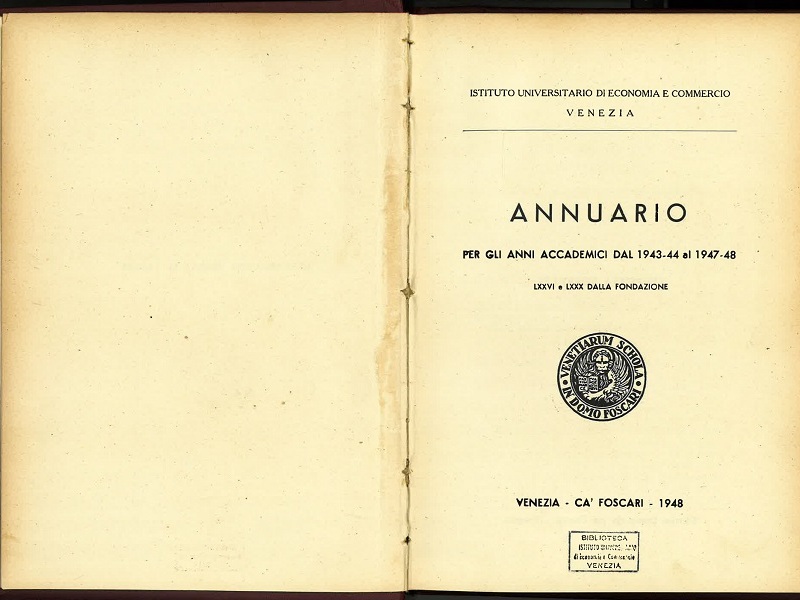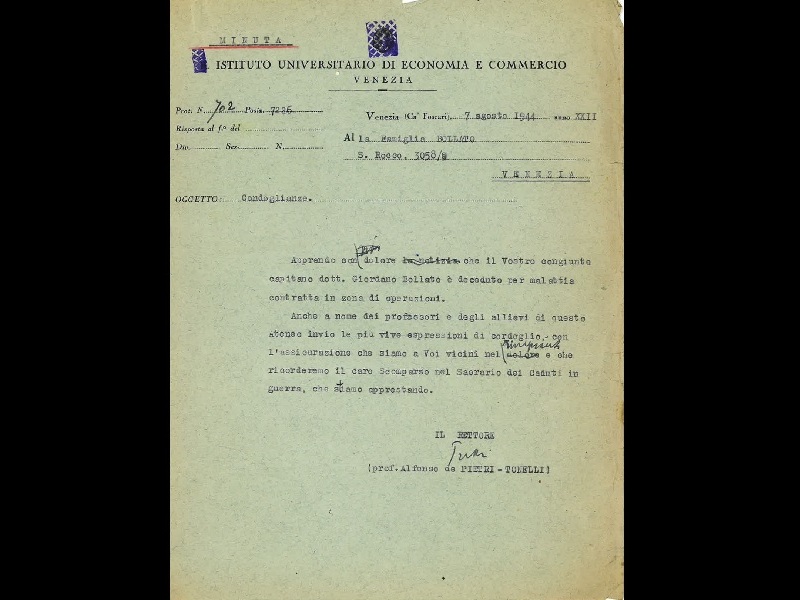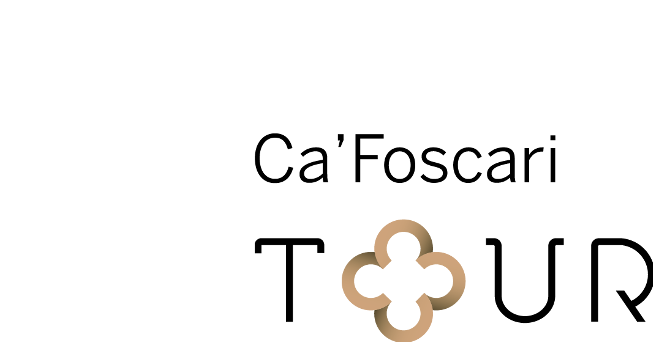Current exhibition: Ca’ Foscari and the Resistance: Stories of Ca’ Foscari Partisans
2025 marks eighty years since the Italian Liberation from Nazi-Fascism (25 April 1945). On November 10th, 1945, just a few months after that momentous date, Gino Luzzatto delivered the inaugural speech for the Academic Year 1945/46 saying: "For twenty months, from September 1943 to April 1945, Northern Italy lived in an atmosphere of civil war that unfortunately grew more atrocious month by month."
This small exhibition offers you a journey through the memory of Ca’ Foscari's participation in the Resistance, recounting some of the stories of the student partisans who died while fighting for Liberation and are commemorated on the plaque in the Niobe Courtyard (open to visitors). It also commemorates Ca’ Foscari students and graduates who survived the war and dedicated a significant part of their lives to the partisans’ cause.
Since 2018, all information regarding the Ca’ Foscari victims of the struggle against fascism has been collected in a special database (Database dei Caduti di Ca' Foscari). Further insights into the history of Ca’ Foscari can be found in Phaidra, the History of Ca’ Foscari University of Venice.
Showcase 1
1 - Yearbook for the academic years from 1943-44 to 1947-48, Istituto Universitario di Economia e Commercio. Venice, Ca’ Foscari 1948.
These pages present the inaugural speech for the academic year 1945-1946, in which Rector Gino Luzzatto reflects on the return to normalcy after the end of the Second World War, revisiting the difficult moments of the previous three years and commemorating the fallen of Ca’ Foscari.
In his speech, Luzzatto pays homage to the staff and professors and, with even greater emphasis, to the students, among whom the losses were more numerous. The same volume, following the inaugural speech of the academic year 1946-47, offers a chronicle of the conferral of honorary degrees to 75 Ca’ Foscari students on July 16, 1947 (p.42). Partisans Rinaldo Arnaldi, Gastone Bragagnolo, and Ampellio Iberati, whose stories are narrated in this showcase, are mentioned there.


2 - Rinaldo Arnaldi (1914 - 1944)
Rinaldo Arnaldi was born in 1914 in Dueville (Vicenza), into a family strongly opposed to the fascist regime. He attended high school at the episcopal college of Thiene, where in 1933 he took part in the defence of Pietro Galletto, a law professor who was forcibly transferred owing to his opposition to the National Fascist Party. For this act and his family's anti-fascist stance, Arnaldi was placed under public authority surveillance. In 1934, he enrolled in the Faculty of Economics and Commerce at Ca’ Foscari, where he graduated in 1940. Despite being initially declared unfit, he became a sergeant in the tank corps in Vicenza, but following the Armistice of Cassibile, he spurred the creation of the first partisan formations on the Asiago Plateau. He formed the Mazzini Brigade with other comrades, becoming its commissioner and later its commander, adopting the nom de guerre "Loris." He actively participated in perilous expeditions in Switzerland and safeguarded fleeing Jews, aided by his sister Mary, Gino Soldà, Torquato Fraccon, and Don Antonio Frigo. In February 1944, together with the Frigo family, he led a group comprising the Jewish families Klein and Landmann, two British soldiers, and two Italian soldiers. He died in September 1944 alongside 22 other partisans during a firefight with the enemy on the Asiago Plateau. In 1983, he was recognised by Yad Vashem, the National Holocaust Memorial, as Righteous Among the Nations.
In this showcase you can see Arnaldi’s honorary degree and the photograph of his student file, preserved in our historical archive.


3 - Gastone Bragagnolo (1920 - 1944)
Gastone Bragagnolo was born in 1920 in Cassola (Vicenza). He enrolled at the Istituto Universitario di Economia e Commercio Ca’ Foscari in Venice in November 1940 as a student of Foreign Languages and Literatures. He served as a sergeant in the Alpini (the Italian Army's specialist mountain infantry) during the war; following the Armistice of 8 September 1943, he joined the partisan movement and became a member of the "Italia Libera Campo Croce" brigade, established in March 1944. He was hanged alongside 31 other partisans on 26 September 1944, during the Bassano massacre, as part of Operation Piave executed by Nazi-Fascist forces. Each partisan wore a sign around their neck with the inscription "Bandit." The execution was staged on the principal tree-lined avenues of Bassano, as a warning to all. On those same trees along Viale Venezia in Bassano, plaques shaped like crosses are now placed in memory of the fallen.
In July 1947, Rector Gino Luzzatto conferred an honorary degree on Gastone Bragagnolo. The commemorative inscription on the first anniversary of Gastone Bragagnolo's death is displayed here, from the student file preserved in our historical archive.


4 - Ampellio Iberati (1917 - 1944)
Ampellio Antonio Iberati was born in 1917 in Portogruaro (Venice), the second of five brothers. In the academic year 1938-39, he enrolled in the first year of the Faculty of Foreign Languages and Literatures at the Istituto Universitario di Economia e Commercio in Venice. He was part of the Carabinieri Territorial Legion of Trieste. In 1944, the Venetian Commission for the Recognition of Partisans wrote to the Presidency of the Council of Ministers to request the awarding of the Silver Medal to Iberati. In 1945, Ca’ Foscari received a letter from some students requesting that he be honoured with an honorary degree, given that he had sacrificed his life in the fight for Liberation.
From a document of the Corpo Volontari della Libertà (Volunteer Corps for Freedom), we learn that, in remembrance of Iberati’s heroic deeds, one of the Garibaldi Assault Brigades was named after him: “Ampellio Iberati”. A letter written by his brother Benito in 1976 informs us that on 18 December 1944, Iberati was hanged by the Nazi-Fascists in Portogruaro. On 16 July 1947, Gino Luzzatto, Rector of the Istituto Universitario di Economia e Commercio in Venice, conferred upon Ampellio Antonio Iberati an honorary degree in Foreign Languages and Literatures.
This showcase contains a commemorative postcard sent to Ca’ Foscari by Iberati’s family, a note from his friend Angelo Grillo, and the rector Gino Luzzatto’s notification of the honorary degree conferment.




5 - Giordano Bruno Bollato (1905 - 1944)
Giordano Bruno Bollato was born in Venice in 1905. His life was shaped by two world wars and personal hardships: his father passed away in 1912, leading to his placement in the Male Orphanage of the Congregation of Charity in Venice. Despite these challenges, Giordano excelled academically, earning high grades and numerous awards. In 1932, he began studying Economics and Commercial Sciences at Ca’ Foscari in Venice while employed by the National Institute of Social Security in Padua. He graduated on 8 March 1940, although he had been drafted into the military in August 1939. He first served in the Navy before transitioning to the specialist mountain infantry (Alpini). After being deployed to Greece, he was stationed in Croatia, Bosnia, and Montenegro, where he learned of the Armistice. As he refused to surrender to the Germans, he travelled back to Italy and joined the Italian Partisan Division Garibaldi. He chronicled his struggles and hopes for peace in a personal diary, which is preserved by his family and partially published in issue no. 126 (2024) of the magazine Protagonisti. In January 1944, he was captured by German forces and interned in the Semlin concentration camp (Belgrade), where he passed away on 4 February 1944 due to illness.
This showcase displays the epitaph published by his family in the newspaper Il Gazzettino, the letter of condolence from Rector Alfonso de Pietri Tonelli to the family, and the thank-you note that the Bollato family sent to Ca’ Foscari in response to the condolences.



Showcase 2
6 - Giuliana Foscolo (1913 - 2001)
Giuliana Foscolo was born in 1913 in Venice to a family of noble lineage. Although her father, an anti-fascist lawyer, held conservative views on women's roles, Giuliana managed to secure permission to pursue her secondary education, during which the poet and writer Diego Valeri was one of her professors, and later to attend university, enrolling at Ca’ Foscari in 1930. She graduated in English Language and Literature from Ca’ Foscari in 1935 with a thesis on Mary Webb. Within the academic community, she developed a strong anti-fascist spirit, which was further reinforced after she met and married Mario Sonnino. In 1941, she moved with her children to the family estate in Casteldardo di Trichiana, while her husband soon fled to Switzerland. After the Armistice on 8 September 1943, she became a partisan under the name “Pierina” and assisted disbanded soldiers, fleeing British prisoners, and persecuted political figures. In 1944, she opened her villa as a refuge for partisans, becoming a key figure in the local Resistance. She hosted Allied missions and managed secret communications. During the conflict, she hid and cared for the wounded, including the American Major Benucci. After the war, she was recognised as a combatant partisan and awarded the War Cross of Military Valour. She is remembered for her commitment to the united anti-fascist front and her dedication to social justice.
This showcase displays a photograph from Giuliana Foscolo’s student file, preserved in our historical archive.


7 - Ida D’Este (1917 - 1976)
Ida D’Este was born in Venice in 1917 to a cultured and affluent family. In 1936, she enrolled in the Faculty of Modern Languages and Literatures at Ca’ Foscari University, graduating in 1941 with a thesis on French literature entitled L’homme dans la pensée de Pascal. After 8 September 1943, she and her friends from the Catholic lay association Azione Cattolica organised regular aid for Italian soldiers imprisoned on ships docked in the port of Venice and worked on the preparation and dissemination of anti-fascist propaganda. She later took on the role of staffetta (courier) between the Veneto Regional Liberation Committee and the Provincial Partisan Committees. In January 1945, she was arrested by the Nazi-Fascists and endured brutal torture and interrogations, first in Padua and later in Campo Tures, Bolzano. Following the Liberation, she entered politics: in 1946, she was elected as a Municipal Councillor in Venice, and in 1948 and 1953, she represented the Christian Democrats in the Chamber of Deputies. The notes she wrote immediately after the war formed the basis of her book Croce sulla schiena (A Cross on the Back), published for the first time in 1953. The cross in the title references both her deep Catholic faith and the yellow cross painted on the uniforms of prisoners in the Bolzano concentration camp. In her book, D’Este recounts various moments of her experience as a partisan.
This showcase displays a photograph of Ida D’Este from her student file in our historical archive, as well as the second edition of Croce sulla schiena (1966). On page 9, there is the cover of the first edition (1953).


8 - Berta Bianca Spitzer (1916 - 1997)
Bianca Berta Spitzer was born in Vienna in 1916 into a Jewish family of Central European intellectuals. Her father, Carolj Spitzer, of Croatian origin, had studied in Hungary and embraced a strong Marxist philosophy. After completing her secondary education at the Istituto Magistrale of Trieste, she enrolled in the Faculty of Modern Languages and Literatures at the Istituto Universitario di Economia e Commercio in Venice in 1936. While at university, Bianca met Ernesto Norbedo, a Catholic and a pupil of Gino Zappa, whom she married in August 1938, before the racist laws came into effect. She graduated with a thesis titled "Outstanding Female Characters in the English Novel of the 19th Century," supervised by Professor Ernesto Cesare Longobardi, in the autumn session of the 1939-40 academic year. Following the Armistice of 8 September 1943, she was evacuated along with her mother and son to San Martino di Lupari (Padua), where she worked both as a translator for the Austrian headquarters and as a partisan staffetta.
This showcase displays a photograph of Berta Bianca Spitzer and her marriage certificate, preserved in her student file in our historical archive.


9 - Pietro Beghi (1905 - 1970)
Pietro Beghi was born in 1905 in Canaro di Rovigo (Rovigo), the son of Davide Galileo Beghi, a physician and a deputy of the Socialist Party. He enrolled in the Istituto Universitario di Economia e Commercio at Ca’ Foscari, graduating on 3rd December 1929. Beghi refused to join the Fascist Party and began his career as an auditor, subsequently becoming the general attorney for the family business in La Spezia, followed by work at a shipyard in Portovenere. In October 1943, he helped establish the Provincial Liberation Committee of La Spezia, where he was appointed as Secretary. After the war, he held various political and administrative positions. He died in La Spezia on 21st June 1970.
This showcase contains Pietro Beghi’s student file, preserved in our historical archive.


Bibliography
- Il Veneto nella Resistenza: contributi per la storia della lotta di liberazione nel 50° anniversario della Costituzione, a cura di Associazione ex Consiglieri della Regione Veneto, Venezia, 1997.
- Bon, Silva. Sarà ancora bello: storie di donne della Venezia Giulia tra fascismo, Resistenza e dopoguerra. Centro Isontino di ricerca e documentazione storica e sociale «Leopoldo Gasparini». Gorizia: Grafica Goriziana, 2004.
- D’Este, Ida. Croce sulla schiena. Roma: Cinque Lune, 1966.
- Ponzani, Michela. Guerra alle donne: partigiane, vittime di stupro, amanti del nemico, 1940-45. Einaudi storia. Torino: Einaudi, 2012.
- Saonara, Chiara, e Angelo Ventura, a c. di. Le missioni militari alleati e la Resistenza nel Veneto: la rete di Pietro Ferraro dell’OSS. 1a edizione. Annali / Istituto Veneto per la Storia della Resistenza 9/10. Venezia: Marsilio, 1990.
- Sega, Maria Teresa. Voci di partigiane venete. Sommacampagna: Cierre, 2016.
- Tobagi, Benedetta. La Resistenza delle donne. Frontiere Einaudi. Torino: Einaudi, 2022.
- Protagonisti : trimestrale di ricerca e informazione, vol. 126, giugno, 2024.
Sitography
Past exhibitions
Flyer past exhibitions
| Eastward Bound: Marco Polo's Journey through Ca' Foscari's Archives August-December 2024 | 1.63 M | |
| Memories of Women between the 19th and 20th Centuries January 2024 - August 2024 | 2.39 M | |
| Ca' Foscari historic and academic venues. Restoration meets sustainability June - December 2023 | 3.08 M | |
| Student unrest at Ca' Foscari: 1967-1978 May 2021 - January 2022 | 1.32 M | |
| Women at Ca' Foscari February 2020 - May 2021 | 1.49 M | |
| Ca’ Foscari and Japan: 1868-1945 June 2019 - April 2020 | 1.34 M | |
| Two Antique Portolan Charts January-May 2019 | 292 K | |
| Statistics at Ca’ Foscari: Debate, Research and Teaching May 2018 - December 2018 | 508 K | |
| Ca’ Foscari’s Centenary: 1868 - 1968 August 2017 - April 2018 | 291 K | |
| Feliciano Benvenuti for the centenary of his birth October 2016 - July 2017 | 190 K | |
| Student life April - November 2016 | 0.93 M | |
| Ca' Foscari Illustrious guests November 2015 - March 2016 | 246 K | |
| Birth of the Royal School of Commerce May - October 2015 | 131 K |

